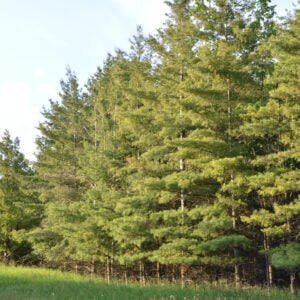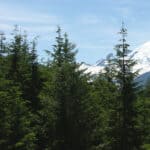Western Hemlock (Tsuga heterophylla)
$49.95
Tsuga heterophylla, commonly known as Western Hemlock, is a stately, evergreen conifer native to the Pacific Northwest of North America. Admired for its soft, feathery foliage and graceful, pyramidal shape, this tree is well-suited to cool-climate gardens and shaded woodland settings. Although Western Hemlock is not commonly planted in Australian gardens, it can flourish in cooler regions such as the Southern Highlands of New South Wales, the Central and Southern Tablelands, the Snow Mountains, and the Alpine region, as well as in the cool temperate areas of Victoria and Tasmania, provided it receives the proper care and conditions.
Tree Height and Spread
In its native habitat, Western Hemlock can soar to heights of 50 to 70 metres, making it one of the tallest conifers in North America. However, in cultivation, especially outside its native range, it tends to reach more modest heights of 15 to 25 metres over many decades, depending on growing conditions.
Its growth habit is typically conical and upright, with a slender crown and drooping leader (the topmost shoot), which gives it a slightly weeping appearance. The horizontal branches are layered and densely clothed in short, flat needles, offering year-round greenery and shelter for wildlife.
The mature spread is generally 4 to 6 metres, though this can vary based on pruning practices and competition from neighbouring trees or structures.
Preferred Soil Type
Western Hemlock prefers rich, moist, well-drained soils with a high organic content. In the wild, it often grows in deep forest humus over loamy, acidic, well-drained soils, where it benefits from cool, shaded root zones and abundant moisture.
To replicate these conditions in a home garden or landscape setting:
-
Prepare the planting area with ample compost or well-rotted leaf litter.
-
Avoid heavy clay or compacted soils, as these may retain too much water and limit root oxygen.
-
Ensure the site offers good drainage while maintaining consistent moisture.
Mulching around the base of the tree with leaf mould, bark chips, or pine needles can help conserve soil moisture, suppress weeds, and mimic the natural forest floor that Western Hemlock favours.
Ideal Soil pH
Western Hemlock thrives in slightly acidic to strongly acidic soils, ideally within a pH range of 4.5 to 6.5. It does not tolerate alkaline or lime-rich soils well, as these can interfere with nutrient uptake and result in yellowing foliage or poor growth.
If you are unsure about your soil’s pH, it’s worth conducting a soil test before planting. If the pH of your soil is too high, you can increase its acidity by adding materials such as compost, manure, leaf litter, and mulch. Iron chelates can also be effective. In more severe cases, consider using powdered sulphur. Apply one handful per square meter, once a year. Keep in mind that sulphur acts slowly, and it may take about six months before you notice a change in the pH.
Light and Temperature Requirements
Although Western Hemlock can tolerate some sun, it performs best in cool, shaded to semi-shaded positions, especially during the hot Australian summer. In its natural range, it thrives beneath a forest canopy and, as such, is well adapted to growing as an understory tree.
If planting in an open site, choose a location that offers protection from the harsh afternoon sun, such as the southern side of a building or amongst taller trees. Ideal growing regions include Tasmania, parts of Victoria, the NSW Southern Highlands, and elevated areas of the ACT.
Western Hemlock is frost-hardy and prefers cool, moist air. Avoid planting in areas that experience prolonged drought, high summer heat, or hot drying winds unless irrigation and shelter are provided.
Watering and Maintenance
Western Hemlock has a shallow, fibrous root system that appreciates regular moisture, especially during establishment. In the first few years, water deeply and consistently, particularly through dry spells or during warmer months. The Western Hemlock is drought sensitive. Consider drip irrigation during warm periods to ensure consistent soil moisture.
This species requires minimal pruning. If needed, prune only to remove dead, damaged, or congested growth, and always avoid cutting into old wood as this can leave permanent gaps in the foliage.
Tsuga heterophylla, commonly known as Western Hemlock, is a graceful and refined conifer that brings elegance, shelter, and year-round greenery to cool-climate gardens. While it thrives in moist, shaded areas with acidic soils, it becomes relatively low-maintenance once established and can live for many years, making it a long-lasting feature tree. This species is ideal as a specimen in large gardens or arboretums, as well as in forest gardens and along sheltered garden edges. Western Hemlock is a rewarding choice for those who have the space and climate to support its growth.
| Container size | |
|---|---|
| Enabled Shipping Locations | , , , , |
| Environment | , , , , |
| Feature | , , , , , , , |
| Flower Colour | |
| Foliage Colour | , |
| Mature Plant Height |
Above 30 metres |
| Mature Plant Spread |
9 to 10 metres ,over 10 metres |
| Soil Type | , , |
| Sun | , , |
| Water Requirements | , |
Only logged in customers who have purchased this product may leave a review.
RELATED PRODUCTS

















Reviews
There are no reviews yet.